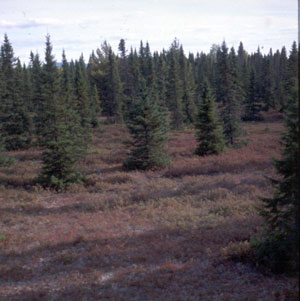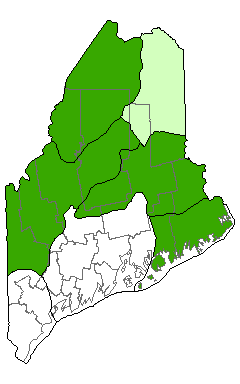DACF Home → Bureaus & Programs → Maine Natural Areas Program → Communities, Plants, and Animals → Natural Community Fact Sheets → Black Spruce Barren
Printer Friendly Fact Sheet - 580 KB pdf (Get a free copy of Adobe Acrobat Reader)
Black Spruce Barren
Scientific Name: Spruce - Heath Barren; State Rank: S2

- Community Description
- Soil and Site Characteristics
- Diagnostics
- Similar Types
- Conservation, Wildlife and Management Considerations
- Distribution
- Characteristic Plants
- Associated Rare Plants
- Associated Rare Animals
- Examples on Conservation Lands You Can Visit
Community Description: Black spruce, sometimes mixed with red spruce (and hybrids between the two), forms a variable canopy over heath shrubs, mosses, and lichens. Canopy closure is usually 25-60%, occasionally greater. Associates include balsam fir, larch, and white spruce. The shrub/sapling layer is usually well developed (>25%) and may be very dense; mountain holly and wild-raisin are characteristic shrubs. Dwarf shrubs, herbs, and regenerating trees cover the ground layer, with heath shrubs prominent. Bryoid cover is close to 100%; mosses dominate many areas, but in drier sites reindeer lichens may be abundant. Openings with blueberry and lichens may occur within the barrens. Wetter sites may approach concepts of boreal ‘muskeg’, though they are not true peatlands. Back to top.
Soil and Site Characteristics: Sites occur on flat to rolling terrain in cold lowlands (usually <1200’ elevation) characteristic of nutrient-poor or highly acidic sites. The sandy to clayey soils over till can vary (even within the same site) from well drained to very poorly drained, reflecting the microtopography. Wet areas may have an organic layer of up to 25 cm over the mineral soil. Sites often contain evidence of fire. Back to top.
Diagnostics: A somewhat open spruce canopy, usually including black spruce, occurs with prominent shrub and herb layers (typically > 25% cover each). Heath shrubs may form dense thickets. Sites are underlain by mineral soil sometimes overlain by a thin organic layer. Back to top.
Similar Types: Lower-elevation Spruce - Fir Forest and Maritime Spruce - Fir Forests have far lower shrub and herb cover and generally lack black spruce. Black Spruce Woodlands and Spruce - Pine Woodlands share many species but are on bedrock rather than mineral soil. Black Spruce Woodlands in particular may co-occur with this type, and further work is needed to distinguish the two types. Spruce - Fir Wet Flats have more closed canopies with red spruce dominant and lack the abundant heath shrubs. Black Spruce Bogs are on deeper (>1 m) peat deposits. Back to top.
Conservation, Wildlife and Management Considerations: The extent of this type in Maine has not been well documented, nor have site and successional relationships. This type appears mostly in areas that have burned within the last century or so and that also have a cool microclimate. Several known sites are in conservation ownership.
Birds that may nest in this habitat include the Lincoln's sparrow, fox sparrow, palm warbler, and blackpoll warbler. Back to top.
Distribution: Eastern and far northern Maine, extending into Canada; part of the New England - Adirondack Province. Landscape Pattern: Large Patch. Back to top.


Characteristic Plants: These plants are frequently found in this community type. Those with an asterisk are often diagnostic of this community.
- Canopy
- Balsam fir
- Big-toothed aspen*
- Black spruce*
- Red spruce*
- White spruce
- Black spruce
- White pine
- Sapling/shrub
- Balsam fir*
- Gray birch*
- Mountain holly
- Red spruce*
- White pine*
- Dwarf Shrub
- Labrador tea*
- Lowbush blueberry*
- Rhodora*
- Sheep laurel*
- Herb
- Bracken fern
- Bunchberry
- Canada mayflower
- Starflower
- Wild sarsaparilla*
- Bryoid
- Reindeer lichen
- Sphagnum mosses*
- Wavy broom-moss
There are no documented examples of rare plants associated with this natural community.
There are no documented examples of rare animals associated with this natural community.
Examples on Conservation Lands You Can Visit
| Example | County |
|---|---|
| St. John River Preserve | Aroostook Co. |